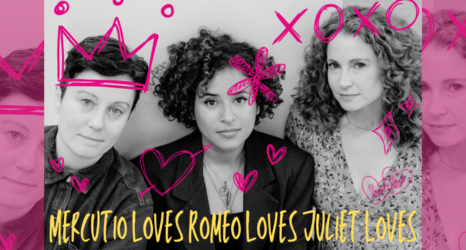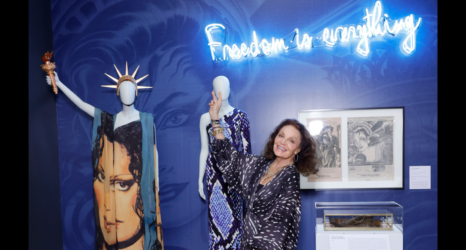“Ultimately, ecofeminist art is not there just to be looked at, provoke or simply be admired. It proposes solutions for the planet and our survival—both spiritual and practical.”
—Monika Fabijanska, curator of ecofeminism(s)
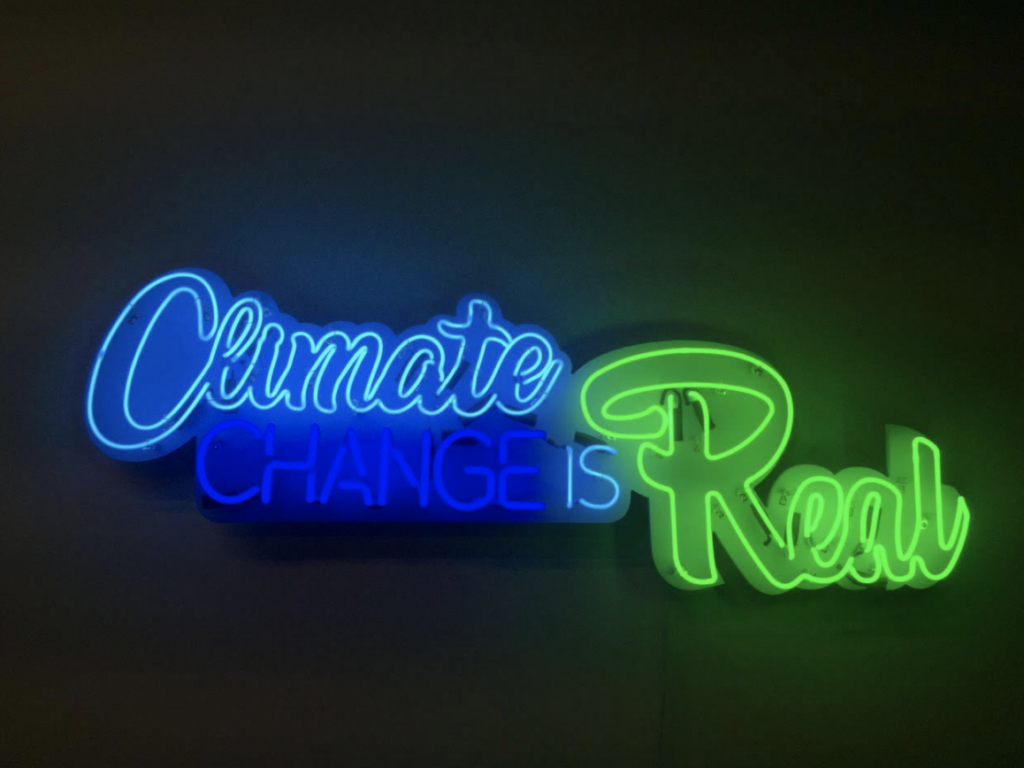
The beginnings of ecofeminist art harkens back to the 1960s—owing to the development of conceptual art, spiritual feminism and the exclusion of women from the art market. Employing new mediums and exploring space outside of the galleries, women artists imbued with social activism created art that “delights the eye, provokes the mind, and can inspire change.”
Featuring works by 16 women artists from the first-generation feminists to the youngest generation, the ecofeminism(s) exhibition at the Thomas Erben Gallery in New York City presents this powerful message connecting aesthetic sensibilities with physical reality.
“The country is experiencing several national crises, all at once: the increased awareness of racial and economic inequities, the novel pandemic that fell unequally on the poor and ethnic minorities, and the economic collapse unequaled in living memory,” said Monika Fabijanska, curator of the exhibition.
“While the art we present today is not a fair match in addressing these crises, in its way it does attempt to challenge the status quo and the dangers posed by continuing as before. Imagine, if a virus was able to dislodge the global system and exacerbate inequities, what consequences are we inviting in not remedying an even more encompassing and consequential threat?”
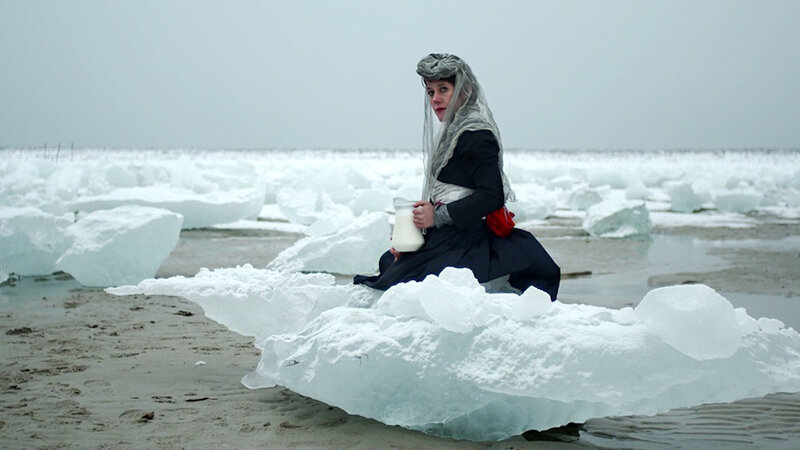
Going right to the heart of the matter, Jessica Segall’s stunning work A Thirsty Person, Having Found a Spring, Stops to Drink, Does Not Contemplate Its Beauty (2011), expresses what mere words can not explain. This haunting photograph documents a performance which suggests mourning for our environmental losses. It was created at the Global Seed Vault on the island of Spitsbergen.
For another work, Fugue in B Flat (2016), Segall travelled with a bee rental business to create an interspecies sculpture with visual and audio feedback of a natural system of logic and survival colonizing a man-made system of order.
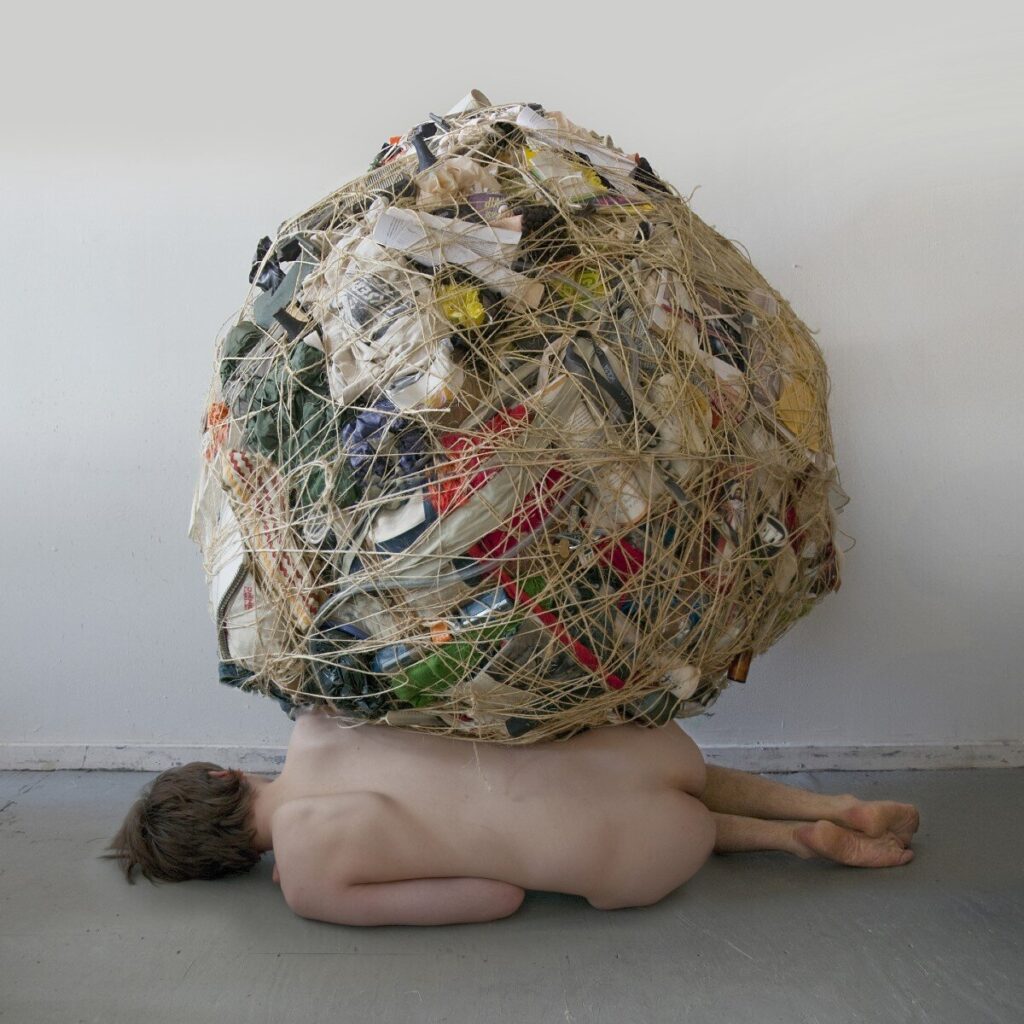
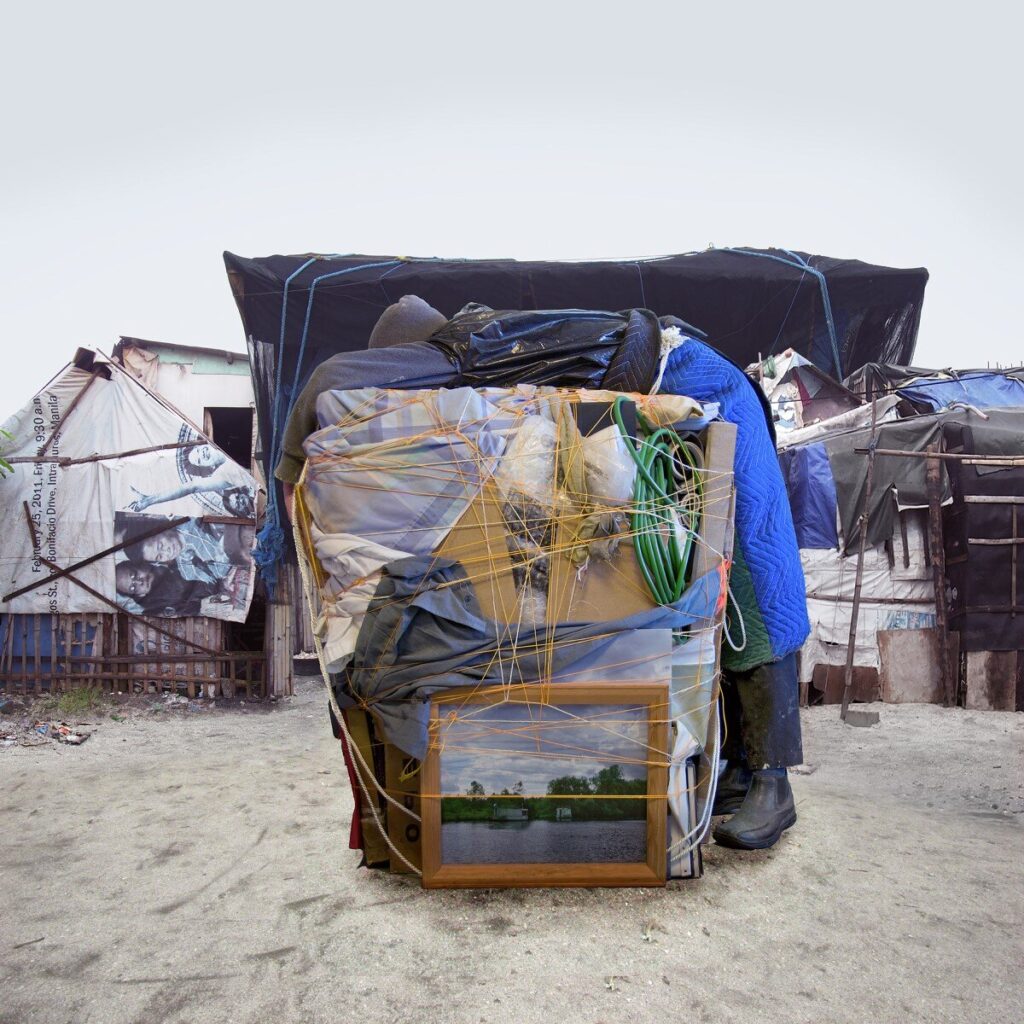
Mary Mattingly’s photographs, Life of Objects (2013) and The Damned (Titian, again) (2013) are statements about mass-produced objects, exploiting resources and people on a global level. Wrapping all her belongings in large bundles, she pushed and pulled these sculptures through streets, photographing them against the scale of the human body.
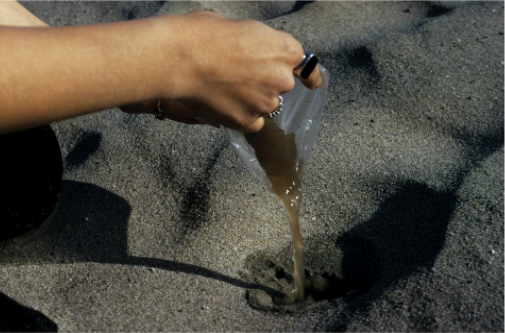
In the era of the #MeToo Movement and climate change, the art of Aviva Rahmani—who made the connection between ecocide and the abuse of women in her early 1970s works—can finally be fully appreciated.
An early performance piece Physical Education (1973), presented in its original format of a slide projection, paved the way for the practice Rahmani calls practical ecofeminism—“the work of artful repair to damaged ecosystems.”
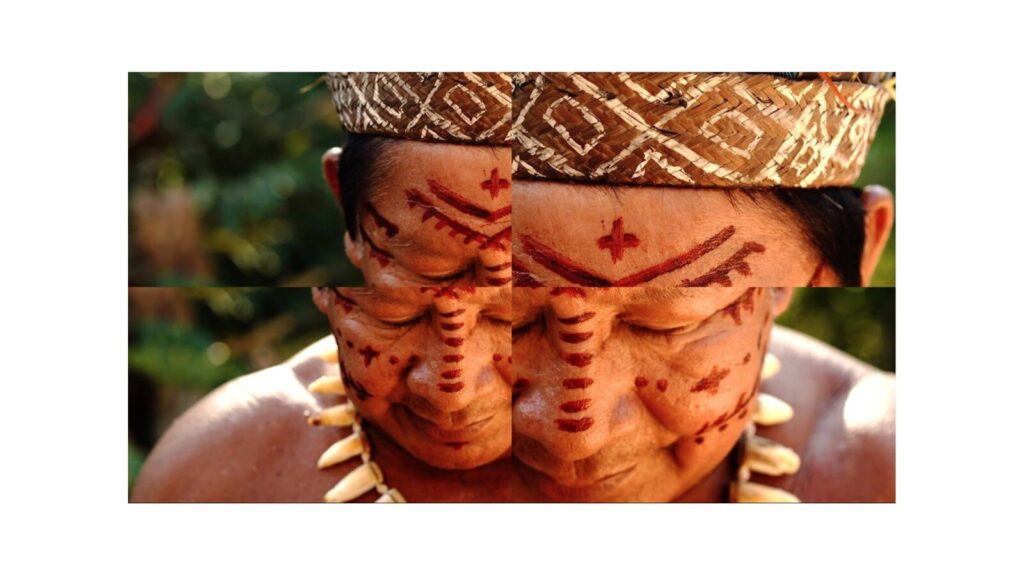
“Ecological consciousness is inherent in the work of indigenous artists, whose practice has been an inspiration to others,” says Fabijanska.
Cecilia Vicuña’s unique oeuvre connects the political, environmental and indigenous in her precarios (1966- present) in which natural and man-made materials combined through rituals and assemblage. Carla Maldonado’s haunting film Dystopia of a Jungle City, and the Human of Nature (2019) calls forth the imminent threat to the Amazon jungle and its native inhabitants.
The exhibition features several works by early ecofeminist artists. Besides Rahmani and Vicuña, a minimalist artist Bilge Friedlaender is represented. Her handmade paper sculpture Cedar Forest (1989), belongs to her series of works commenting on the Epos of Gilgamesh. Presenting the story of a Sumerian king who cuts down a forest in quest of fame, the artist questions the myth of the male hero and calls for “the awakening of female consciousness,” invoking the goddess, Ishtar.
Considered the first ecological site work, Agnes Denes’ Rice/Tree/Burial dates from 1968, when it was created as a private ritual. Re-enacted a decade later on a much larger scale, the project included a burial of a letter to the people of the future. The act of burial itself signified passing and reconnecting with the earth.
Betsy Damson is known for her large public works focused on decontaminating water, like a 6 acre city park in Chengdu, China. Memory of Clean Water (1985) is her breakthrough installation: a cast of a dry riverbed in Utah made in paper pulp – a memorial to a river before it was dammed.
The exhibition ecofeminism(s) also presents the latest ecofeminist artworks that are literally being made now. In a project created especially for this exhibition, Eliza Evans offers the mineral rights to 3 acres of her land in Oklahoma for sale to 1,000 people, in order to prevent fossil fuel development in the area.
ecofeminism(s) features diagrams for Lynn Hershman Leeson’s newest project, Twisted Gravity, which will premiere at her exhibition at the New Museum in 2021, engages with the latest in applied science – a revolutionary off-the-grid water filter able to kill bacteria and degrade plastic. In this new work, the idea of survival through change meets the feminist interest in change as a life cycle.
How to View “ecofeminism(s)” in Person
ecofeminism(s) explores the legacy of some of the pioneers of ecofeminist art: Helène Aylon, Betsy Damon, Agnes Denes, Bilge Friedlaender, Ana Mendieta, Aviva Rahmani, and Cecilia Vicuña, and how their ideas and strategies are continued, developed or opposed by younger generations – Andrea Bowers, Eliza Evans, Sonya Kelliher-Combs, Carla Maldonado, Mary Mattingly, Jessica Segall, and Hanae Utamura. It also features ecofeminist works of Lynn Hershman Leeson and Barbara Kruger, who escape these categories.
The exhibition ecofeminism(s) will re-open to the public Tuesday, September 8 until Saturday, September 26, 2020—Tuesdays through Saturdays, 10 a.m. to 6 p.m. EST at Thomas Erben Gallery: 526 West 26th Street, 4th Floor, New York, NY 10001.
Four visitors at a time; masks are required. There is a sink on the way to the gallery for hand washing.
More information is available here and here.
How to View “ecofeminism(s)” Digitally
On Thursday, September 10, 6:30 p.m. EST, join a complimentary webinar about the critically-acclaimed exhibition: Spotlight on ecofeminism(s)—with exhibition curator Monika Fabijanska, gallerist Thomas Erben, and Christie’s Education’s Julie Reiss for a discussion about the show’s timeliness and the increasing centrality in the art world of art grounded in ecological and other human rights concerns. Register here.
On Wednesday, September 16, 6:30 PM EST, join a Zoom conversation with Raquel Cecilia Mendieta, niece and goddaughter of Ana Mendieta; and Mira Friedlaender, daughter of Bilge Friedlaender; moderated by Monika Fabijanska. Register here.
Previous recorded programs include conversations on ecofeminism with the exhibition artists
- July 8: Lynn Hershman Leeson, Mary Mattingly, Hanae Utamura, Julie Reiss, Ph.D., Christie’s Education. Watch the recording.
- July 15: Aviva Rahmani, Sonya Kelliher-Combs, Jessica Segall, Candice Hopkins—curator, writer, a citizen of Carcross/Tagish First Nation. Watch the recording.
- July 22: Betsy Damon, Eliza Evans, Carla Maldonado, Eleanor Heartney—art writer, contributing editor, Art in America. Watch the recording.
A gallery walkthrough with the curator is available below:




